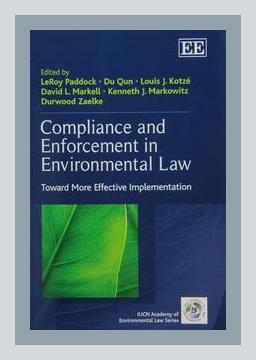Business Law and EthicsRegulatory Compliance
Introduction
“Compliance and Enforcement in Environmental Law” by LeRoy Paddock provides a comprehensive study on the mechanisms, challenges, and strategies involved in ensuring adherence to environmental regulations. This 2020 publication addresses the multifaceted nature of compliance and enforcements within the regulatory compliance category. Throughout the book, Paddock emphasizes the importance of stringent enforcement measures, innovative compliance strategies, and the integration of various stakeholders in achieving environmental protection goals.
Major Points and Concrete Examples
- Understanding Regulatory Compliance
- Major Point: The foundational step in ensuring environmental law compliance is understanding the regulatory framework.
- Example: Paddock details the Clean Air Act (CAA) and its significance in setting air quality standards.
-
Actionable Advice: For individuals working in sectors regulated by the CAA, it is imperative to stay updated with amendments and state-level implementation plans to ensure full compliance.
-
The Role of Enforcement
- Major Point: Effective enforcement is crucial for the success of environmental regulations.
- Example: The book discusses the Environmental Protection Agency’s (EPA) use of fines and sanctions to deter non-compliance.
-
Actionable Advice: Stakeholders should establish robust internal protocols for periodic audits to avoid potential violations and subsequent penalties.
-
Collaborative Approaches to Enforcement
- Major Point: Collaboration between federal, state, and local agencies enhances enforcement effectiveness.
- Example: Paddock mentions the cooperative enforcement used under the Resource Conservation and Recovery Act (RCRA), which involves multiple governmental layers.
-
Actionable Advice: Engage in regular communication and joint training sessions with local and state agencies to align enforcement efforts.
-
Challenges in Achieving Compliance
- Major Point: Companies often face significant hurdles in achieving full compliance due to various factors.
- Example: The book highlights the economic and technological challenges small businesses encounter in adhering to environmental regulations.
-
Actionable Advice: Small businesses should seek grants or subsidies offered by environmental programs that provide financial assistance for implementing compliance measures.
-
Technological Innovations in Monitoring Compliance
- Major Point: Advances in technology play a pivotal role in monitoring compliance efficiently.
- Example: Paddock illustrates the use of remote sensing technology to monitor emissions and environmental quality.
-
Actionable Advice: Integrate modern monitoring technologies such as drones and sensors to streamline real-time data collection and compliance checks.
-
Public Participation in Environmental Enforcement
- Major Point: Public involvement is vital for the transparency and accountability of enforcement procedures.
- Example: Citizen suits under the Clean Water Act (CWA) demonstrate successful public engagement in holding violators accountable.
-
Actionable Advice: Facilitate community workshops and education programs to empower the public with knowledge and tools for active participation in compliance monitoring.
-
Voluntary Compliance Programs
- Major Point: Encouraging voluntary compliance through industry initiatives can complement regulatory enforcement.
- Example: The book describes the success of the Green Power Partnership, which motivates companies to adopt renewable energy practices voluntarily.
-
Actionable Advice: Participate in or initiate voluntary programs that align with industry sustainability goals, enhancing environmental stewardship beyond mandatory requirements.
-
Compliance Assistance Programs
- Major Point: Offering compliance assistance can help entities better understand and meet regulatory obligations.
- Example: Paddock highlights the EPA’s Compliance Assistance Centers, which provide sector-specific guidance and resources.
-
Actionable Advice: Utilize these centers or similar programs to gain industry-specific insights and tools for achieving compliance.
-
Penalty Policies and Deterrence Strategies
- Major Point: The establishment of clear penalty policies helps deter potential violators.
- Example: The EPA’s Civil Penalty Policy outlines how penalties are calculated to ensure fairness and consistency.
-
Actionable Advice: Develop internal guidelines mirroring these penalty policies to maintain a fair disciplinary system within the organization.
-
Environmental Auditing and Self-Reporting
- Major Point: Regular environmental audits and self-reporting mechanisms encourage proactive compliance.
- Example: The book references the EPA’s Audit Policy, which incentivizes self-reporting of violations with reduced penalties.
- Actionable Advice: Implement periodic self-audits and establish a self-reporting protocol to identify and address potential compliance issues ahead of regulatory audits.
-
Training and Capacity Building
- Major Point: Continuous training and capacity building are essential for maintaining high compliance standards.
- Example: Paddock discusses various EPA training programs that target improving understanding of environmental regulations.
- Actionable Advice: Invest in regular training sessions for staff on the latest regulatory changes and compliance techniques to ensure they are well-equipped to meet requirements.
-
International Perspectives on Compliance and Enforcement
- Major Point: Learning from international best practices can enhance domestic compliance strategies.
- Example: The European Union’s stringent environmental regulations and enforcement mechanisms provide valuable insights.
- Actionable Advice: Study international laws and practices, and adapt successful strategies to local contexts to improve compliance efficacy.
Conclusion
LeRoy Paddock’s “Compliance and Enforcement in Environmental Law” underscores the complexity of achieving regulatory compliance through a detailed exploration of case studies, enforcement strategies, and the interplay between various stakeholders. By emphasizing collaborative efforts, innovative technologies, and the importance of public participation, Paddock offers a roadmap for effective environmental law enforcement. Concrete examples throughout the book guide practitioners in implementing practical measures to improve compliance outcomes, making the book a crucial resource for regulators, businesses, and environmental advocates alike.
